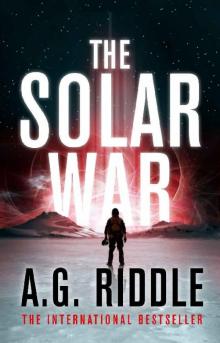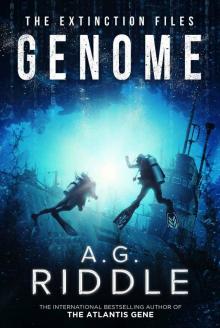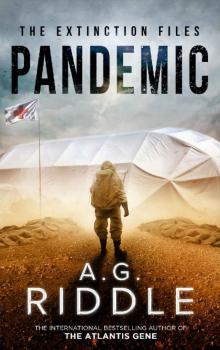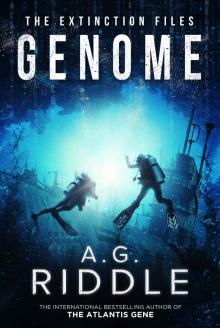- Home
- A. G. Riddle
Winter World Page 12
Winter World Read online
Page 12
For the most part, I spend my time in the robotics lab soldering and welding. I’ve got the most dexterity in space of all the crew, except perhaps Min, and he’s got his hands full. I like the work. I like being useful and being part of a crew. It keeps me from thinking about the crew I lost. There’s a deep well of hurt there. My mind runs across it every now and then, and a surge of pain hits me. That place in my mind is sort of like the sprained ankle and bruised rib and sore spots all over me: I forget until the pain reminds me. Those wounds will take time to heal—how long, I can’t even guess. But with each passing day, as we voyage away from Earth, the hurt dulls, and I come alive a little more.
At the outset, I asked if we had enough food and water for everyone on board. The mission was slated for six. With Harry and me added to the crew, the food requirements are up thirty-three percent—and we lost two capsules, or seven percent of our supplies. James assured me we are well stocked. I hope it’s true.
Every now and then Lina comes into the lab to discuss the software for the drones. She’s working on one operating system with drivers for all the different potential hardware designs—which are all over the map: everything from a simple camera drone to a drone with arms to a drone that can assemble like the ship and bore a hole in the artifact. It’s pretty incredible. James has designed comm patches for the drones that can relay data back to the Pax without sending an electronic signal.
And now he and Harry have a big idea they’re pretty nervous about. They’ve called an all-hands meeting to present it, because it will take every one of us to pull it off, and it won’t be easy. It will also risk a huge amount of our drone material. It’s a risk. But we have to take it.
We just have to convince the others.
Chapter 26
James
The crew meets in the largest space on the ship, at the intersection of the major arms. The space is roughly spherical. It has a technical name, the such-and-such, but we’ve all taken to calling it the bubble. There are windows in several directions and a round white table in the center that everyone can strap themselves to.
Emma, Harry, and I have called the meeting to present a plan we think could drastically up our chances of success. It’s a risk, however. I’m a little nervous about it—the meeting, that is—because this is the first major decision point we’ve faced as a crew. It really could go either way.
When everyone’s assembled and floating around the table, Harry opens the meeting.
“We want to send a fleet of drones ahead. We’re calling it the Janus fleet.”
“Objective?” Grigory asks.
“Data gathering,” Harry answers quickly.
Charlotte knits her eyebrows together. “What are we talking about here? Just observation or actual contact with the artifact?”
“Both,” I reply.
Charlotte shakes her head. “I’m against. We need close control when we make first contact. We need to be able to react and adapt our approach. This is too important to trust to a software algorithm or AI.”
I anticipated this reaction from her. I make my voice calm. “Technically, we’ve already made first contact. The initial probe sent data back in proximity to the artifact, and it was destroyed.”
“That supports my argument,” Charlotte says. “Mindless probes are at a severe disadvantage in these kinds of uncertain situations. The stakes are too large and the risk is too great.”
“We,” I motion to Harry and myself, “view that danger as the primary reason to send an advance probe fleet. You’re right, they won’t have a wide range of adaptations, but each probe will have a purpose, and they can learn a lot—without exposing the Pax or risking this crew.”
Charlotte leans in. “We’re here to risk our lives—”
“Wisely,” I counter. “This isn’t about guts, it’s about mission success. If we die before we learn anything, that’s mission failure.”
Min seems to sense things spiraling. He holds up a hand. “It’s obvious there are issues here. It would be a challenge for me to plan flight courses for the drones. Technically, we aren’t even certain where the artifact is. We’ve extrapolated a location based on the last known position and trajectory, but it could be anywhere. If we send the drones in the wrong direction, they could never course-correct. And Grigory would have to solve the propulsion and fuel needs and balance it against our own. With that said, I would like to hear more before we close the issue.”
A mission commander was never formally designated before we launched—but ever since the Pax assembled, Min has been acting like one. Maybe it’s because he’s flying the ship, determining where we go. Maybe he’s just a natural leader. Whatever the case, he’s doing a good job, and it’s helpful at the moment.
I nod to Harry, who continues.
“The Janus fleet would include two scout drones and three specialized drones: observation, communications, and intervention. Five drones total.”
“Size?” Grigory asks.
“Very small,” Harry answers. “Most will be nothing more than a booster and a specialized tool. All will have comm patches.”
“Fuel, energy requirements?”
“Minimal. This is a one-way trip for all the drones except the scout drones. They’ll be larger and will have more acceleration capability. The plan is for one scout to accelerate past the drone fleet and make good time to the artifact. It’ll have a long-range telescope to verify that the artifact is at the location we expect. The goal is for the drone to see the artifact, but not be seen. If the artifact isn’t where we think it will be, the drone will execute a search grid and try to find it, spending a week on the task. Then it will return to the drone fleet and comm-patch the results to the other scout drone as soon as it’s in line of sight of that drone’s telescope. That scout drone will reverse course and make best speed back to us to relay the results.”
“I like this,” Grigory says. “Even if rest of plan is garbage, this part is wise—verifying location.”
I almost laugh out loud. “Thanks for the faith, Grigory.”
“Welcome.”
“I agree, this is a good move,” Min says.
All eyes shift to Lina. “I’m on board.”
Charlotte simply nods. So does Izumi, who’s been silent so far.
“Then what?” Min asks.
Harry steeples his fingers. “Then, from the Pax, we launch a small drone on an intercept course to the Fornax and comm-patch what we’ve learned: artifact location, any messages we want to send from all departments. That’ll apprise them of any course adjustments that should be made and share our notes.”
After a long silence, Grigory says what we’re all thinking: “Assuming Fornax is out there.”
Harry answers quietly. “Yes, this will also answer the question of what happened to the Fornax.”
“And,” I add, “whether we should adjust our drone design objectives.”
“Whether you should build more bombs,” Min says. “If the Fornax isn’t out there or if it lost its offensive payload.”
“Yes,” I reply.
Charlotte’s eyes go wide. “Wait, you’re building drones with offensive capabilities?”
I nod. “We have to. Without Harry, it’s unlikely the Fornax is producing drones at all. Additionally, as Min noted, we don’t know if the nuke made it. Determining the artifact’s vulnerability could fall entirely to us. We don’t have a choice.”
Charlotte inhales. “Have you made the bombs yet?”
“No. We’re still in the design phase.”
“What sort of yield will they carry?” Grigory asks.
“Nothing on a nuclear scale. And some won’t be incendiary at all. We’ll probe a variety of offensive modes. Kinetic assault, electrical, laser, and of course more conventional ordnance, adapted for space.”
Grigory is uncharacteristically cautious when he responds. “If needed, I believe I could repurpose reactor. If given time, I could rig a casing and program an overload.”
<
br /> The reactor is composed of two chambers that each attach to one of the escape pods when activated. The implication of Grigory’s plan is that the escape pods would effectively be disabled, leaving us no way to return to Earth.
“That’s a question for another day,” Min says. “At the moment, let’s focus on the advance drone fleet. What’s the plan after it locates the artifact?”
“Well,” Harry says, “that’s when it gets interesting. The two scout drones will monitor the other three drones as they make a staggered approach to the artifact. The observation drone will be first. It’s designed to look like an asteroid. It’ll do a fly-by of the artifact but make no contact. Along the way, it’ll collect readings—visual, radiation, microwave, radio wave, whatever else anyone wants to scan. We’ll get our first look at its outer material up close, maybe even form a theory about what it’s made of. We’ll see the far side of it as well.”
“See if it has soft underbelly,” Grigory mumbles.
“Exactly.” Harry brings up another image, this one with flight vectors. “After the scans, the scout drone will comm-patch the readings to us—assuming it’s in telescope range of the Pax. The larger data files, like high-res images, will have to travel back to us. After its fly-by, the observation drone will get coordinates for the Pax from the scout drone, then travel back to us with the data.”
I look over at Charlotte. “The comm drone would approach next and initiate contact.”
“And how exactly will it do that?” She asks. Charlotte’s tone is harsh. I think she feels that first contact is her purview and that Harry and I are yanking it away from her because we control the drones and can get there first.
I do my best to keep my voice even, a sharp contrast to Charlotte’s. “That’s not our call.”
Harry shrugs. “Hey, we’re just the drone guys.”
“Have you finished your first contact protocol?” I ask.
Charlotte’s aggression instantly turns to defensiveness. “Well, no, not exactly. This kind of work takes time. It’s not like assembling a robot. We need to be very thoughtful about how we go about this. We get one shot.”
“What’s your current thinking about how we’ll proceed?” Min asks.
“My… current thinking is that we need to establish communications and then develop a lexicon.”
It’s clear that not everyone is familiar with the word “lexicon.” I sometimes forget that English is a second language for some of our crew. Grigory squints. Min’s eyes drift, also trying to place the word. Izumi stares at Charlotte. Lina makes no reaction.
“Ah,” says Charlotte, “we need to devise a vocabulary with which to communicate with the artifact.”
Grigory rolls his eyes. “Which assumes it wants to communicate.”
“Yes. I’m assuming that. I assume you want to shoot first?”
I hold up a hand. “No one’s saying that.”
Charlotte turns to me. “What are you saying, James?”
“That our mission is broader than communicating with the artifact. We’re here to figure what we’re dealing with and to notify Earth.” I wait, but no one says anything. “If the artifact wants to communicate, that’s a best-case scenario. But if it doesn’t, Earth needs to know that. And how to fight it. As you’ve noted, we get one chance to make first contact. After we initiate communication, it will be aware of our drones. We lose the element of surprise.”
“Which is why you want to study it first—with the observation drone?” Min asks.
“Yes. We observe first. Then try to communicate. And if that fails, the intervention drone will probe its defenses. To us, that seems the only logical approach.”
Charlotte chews her lip. “Yeah. All right. I like this. It’s a good idea. Once we initiate communication, the artifact will likely identify the drones. We may not get another chance to get close to it—the observation drone needs to go first.”
“That’s our thinking as well,” I say. “Again, we’re deferring to you on first contact protocol. Any details would be helpful at this point.”
Charlotte interlocks her fingers and sets them on the table. “Okay. My protocol, what I’m thinking, is that we try a series of broadcast modalities. Microwave, radio wave, light, radiation—we keep going down the list until we get a response.”
“What’s the initial message?” I ask.
“Something simple. A non-random number sequence. Fibonacci numbers. Figurative numbers: triangular, square, pentagonal. Central polygonal numbers. Magic square. The idea is that we give it a logical sequence of numbers and wait to see if it responds with the next number in the sequence. If so, that tells us it’s willing to talk. The next part is tougher.”
“How to talk,” I say.
“Exactly. I’m still working on that.”
“Fair enough. My feeling—” I gesture to Harry and Emma. “Our feeling is that establishing a rudimentary initial contact is sufficient for this first pass. It could even inform how you go about creating a more complex lexicon with the artifact.”
After a moment, Charlotte nods. “Yes. I agree. It would give me a big head start. By the time we got there, we could be ready to have a productive dialogue.”
“Or be ready to destroy it,” Grigory says. “That’s what’s in third set of drones, yes? Weapons?”
All eyes turn to me. “That’s right. The first drone will observe. The second will communicate. And if that’s unsuccessful, we probe its defenses. By the time we reach the artifact, we need to be ready to talk or fight. Additionally, this will let us know what we’re dealing with now—whether it’s friendly or aggressive—and we can let Earth know far sooner than expected. We’re still a lot closer to Earth than we will be when we reach the artifact.”
The group falls silent. I think they’ve realized the genius of the plan Harry, Emma, and I have put together. The addition of the Janus fleet is a vast improvement on NASA’s original mission, shaving months off the timeline of determining what the artifact is. It occurs to me now why NASA didn’t designate a mission commander. This is the reason—this meeting. NASA wanted friction. They wanted all these brilliant people to sit in a room and argue—without a clear leader who could end debate and just decide things summarily. This mission is primarily about the research we’re doing, not fast command decisions. They wanted every person to have a specialty and to have a chance to voice their ideas and opinions. That’s how good plans are improved.
“How would it work?” Min asks. “The weapons?”
“We’re designing a rail gun,” Harry replies.
Charlotte grimaces. “I thought a gun wouldn’t work in space.”
Grigory sounds annoyed. “Gun will work in space.”
“Without oxygen?” Charlotte asks.
“Yes,” Grigory snaps. “And a rail gun is nothing like regular gun anyway.”
Harry’s voice is calm and matter-of-fact. “A gun—a conventional gun with a hard projectile and gunpowder as propulsion—will indeed fire in space. The rounds contain their own oxidizer—a chemical that triggers the explosion of the gunpowder and forces the projectile outward, along a path created by a barrel. The reaction doesn’t need any outside oxygen. The main difference in firing a gun in space will be the smoke, which will emerge from the projectile’s exit point at the tip of the barrel.
“But in our case, there won’t be any gunpowder or oxidizer or expanding gas of any kind needed. A rail gun is different in mechanism, though we still use a projectile in a barrel pointed at our target. The barrel in a rail gun has two rails that are magnetized using massive amounts of electricity. The electromagnetic current running down the rails pushes the object out the barrel at extremely high velocity—much, much faster than any explosive round can achieve.”
“What’s the target?” Grigory asks.
“We’d shoot six rail gun rounds concurrently, close grouping,” I reply.
“Center mass?” Grigory asks.
“No. The outer edge.”
> The Russian engineer smiles. “You want a piece of it.”
“To study, yes. We feel the priority is learning what it’s made of. That will tell us more about how to… neutralize it and any other artifacts.”
After a long silence, Min asks, “Is there more?”
“That’s all we’ve got at the moment,” I reply.
“I like it,” Min says.
“As do I,” Grigory adds.
Charlotte nods. “Me too.”
“Same,” Lina says.
All eyes drift over to Izumi. “This is all outside my expertise. I’m here to keep you all alive and performing well. It would seem that this plan does that very well. I am for it.”
I motion to Harry and Emma. “We still have a lot of work to do on our end with the design, and then we’ve got some construction challenges. I think maybe we could be done in two weeks? Three?”
I shift my gaze to Emma. She’s been silent throughout the meeting, for good reason: she knew what Harry and I were presenting. She helped formulate the plan. And she’s essential to executing it. Harry and I are good with design, but when it comes to building the drones, she runs circles around us.
“Definitely,” she says. “Two weeks’ build time is doable based on the prelim designs.”
I address Lina. “We’ll need a lot of help with the software.”
“No problem. I’ve already got a good head start on some autonomous drone systems. But I need the specifics.” She turns to Charlotte. “Protocols for the comms, to start with.”
“I have the basics mapped out. I can clean it up and have it to you in a few days.”

 The Atlantis Gene: A Thriller
The Atlantis Gene: A Thriller The Solar War (The Long Winter Book 2)
The Solar War (The Long Winter Book 2) The Extinction Files Box Set
The Extinction Files Box Set The Atlantis Trilogy Box Set- The Complete Series
The Atlantis Trilogy Box Set- The Complete Series Winter World
Winter World Genome
Genome Pandemic (The Extinction Files Book 1)
Pandemic (The Extinction Files Book 1) The Atlantis Gene: A Thriller (The Origin Mystery, Book 1)
The Atlantis Gene: A Thriller (The Origin Mystery, Book 1) Departure
Departure Genome (The Extinction Files Book 2)
Genome (The Extinction Files Book 2) The Atlantis World (The Origin Mystery, Book 3)
The Atlantis World (The Origin Mystery, Book 3) The Atlantis Plague: A Thriller (The Origin Mystery, Book 2)
The Atlantis Plague: A Thriller (The Origin Mystery, Book 2)